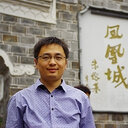Pericyst may be a new pharmacological and therapeutic target for hydatid disease.
Mots clés
Abstrait
BACKGROUND
Most hydatid cysts with calcified walls are biologically and clinically silent and inactive. Transforming growth factor-beta 1 (TGF-β1) plays a critical role in the calcification process of cells. The aim of this study was to assess the effect of modulating TGF-β1 signaling on the calcification of hydatid cysts.
METHODS
Pericyst cells isolated from hepatic hydatid cysts were cultured with osteogenic media. These cells were assessed for alkaline phosphatase activity and mineralization capacity using Alizarin Red staining. Cells were also treated with recombinant human TGF-β1 and TGF-β inhibitor, and the expression profiles of osteoblast markers (RUNX2, osterix, and osteocalcin) were analyzed using Western blotting. The effects of inhibiting TGF-β1 signaling on calcification of pericyst walls were assessed using different doses of TGF-β inhibitor for 7 weeks in a preclinical disease model of liver cystic echinococcosis.
RESULTS
Cells within the pericyst displayed high levels of alkaline phosphatase activity and mineralized nodule formation, as induced by osteogenic media. These activities, as well as expression profiles of osteoblast markers (RUNX2, osterix, and osteocalcin) could be inhibited by addition of recombinant human TGF-β1 (rhTGF-β1) and enhanced by TGF-β inhibitor. In the animal model of cystic echinococcosis, inhibition of TGF-β1 signaling increased calcification of the pericyst wall, which was associated with decreased cyst load index and lower viability of protoscoleces.
CONCLUSIONS
Cells within the pericysts adopt an osteoblast-like phenotype and have osteogenic potential. Inhibition of TGF-β1 signaling increases hydatid cyst calcification. Pharmacological modulation of calcification in pericysts may be a new therapeutic target in the treatment of hydatid disease.



